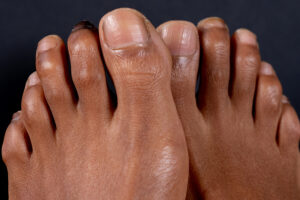Hammertoes Treated in Arlington, VA

Hammertoe treatment may be needed to address a toe that has become permanently locked in a bent-downward position. Often caused by arthritis or tight footwear, a hammertoe can be painful due to constant rubbing and irritation of the bent toe.
At Nirschl Orthopaedic Center, hammertoe treatment is provided by Dr. Matthew Buchanan, a board-certified, fellowship-trained orthopedic foot and ankle surgeon who takes a personalized approach to patient care. With his exceptional skills and compassionate bedside manner, Dr. Buchanan has earned the trust and respect of his patients and peers alike in Arlington, Virginia, and throughout the Washington, DC, metro area.
Conservative Treatment Options for Hammertoes
In most cases, hammertoe pain can be managed with non-surgical treatments, such as:
- Nonsteroidal anti-inflammatory drugs (NSAIDs)
- Physical therapy
- Cortisone injections
- “Buddy taping” (bandaging the injured toe together with an adjacent healthy toe)
- Custom shoe inserts
In general, surgical hammertoe treatment is considered only to address severe or debilitating pain that does not respond to conservative treatment.
Surgical Treatment Options for Hammertoes
The goals of hammertoe surgery are to restore the injured toe to its proper position and correct the muscle imbalance around the affected toe joint, both of which can help relieve pain and improve function. This can be accomplished in several ways, including a:
- Tendon transfer – If the hammertoe is flexible, the tendon underneath it can be rerouted to a new path along the top of the toe, which can help pull the joint into a straightened position.
- Joint resection – If the hammertoe is inflexible, a portion of the affected toe joint can be removed to create the space necessary to straighten the toe.
- Joint fusion – If the hammertoe is inflexible, the affected toe joint can be completely removed so the toe can be realigned; pins, screws or implants may be used to hold the toe straight and allow the ends of the bones to meld together as they heal.
Following any type of hammertoe treatment—conservative or surgical—it is essential to take steps to prevent the problem from recurring. While some risk factors, such as genetics and arthritis, cannot be controlled, others can. For instance, the best way to prevent hammertoes is to always wear roomy, low-heeled shoes that do not create pressure on the toes.
If you would like to discuss hammertoe treatment with Dr. Buchanan, contact Nirschl Orthopaedic Center today at (703) 525-2200 to schedule an appointment at our office in Arlington, VA.
